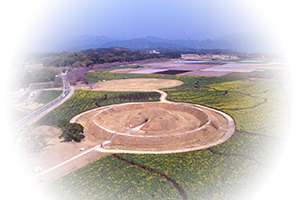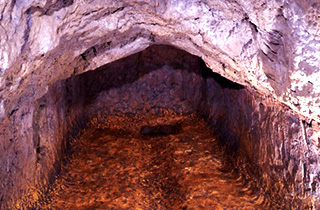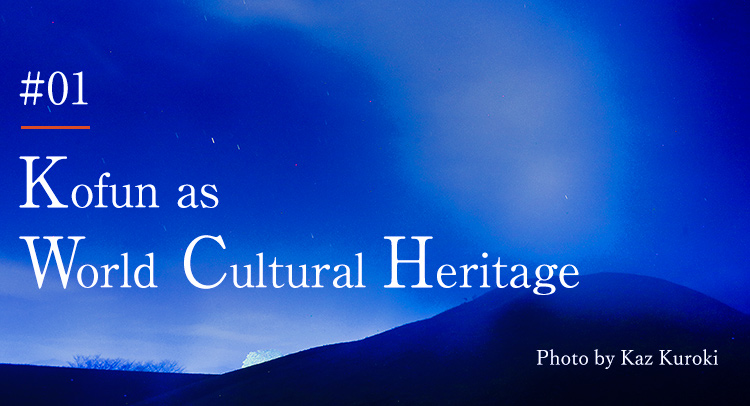Photo by Kaz Kuroki
Registration Criteria of World Cultural Heritage
“Outstanding Universal Value” and “Integrity and Authenticity”
世界文化遺産の登録基準
「顕著な普遍的価値」と「真正性と完全性」

“Outstanding Universal Value” and “Integrity and Authenticity”
世界文化遺産の登録基準
「顕著な普遍的価値」と「真正性と完全性」
Concept behind “Kofun Culture in Southern Kyushu, Japan: The Burial Mounds of Saitobaru Kofun Group and the Surrounding Area”
- 1
Southern Kyushu is significant in that two distinctive burial systems coexisted here. One system consists of keyhole-shaped burial mounds, which were constructed across the Japanese island arc as part of an alliance with royal authorities in the Kinai region. And the other system is characterized by underground tunnel tombs and stone slab tombs, a type of burial system unique to southern Kyushu.
- 2
The introduction of corridor-style stone chambers from the Korean Peninsula led to the establishment of underground tunnel tombs, an innovative form of regional burial system. This then led to the development of tunnel tombs in northern Kyushu. In the course of political and military relations between the Korean Peninsula and the Japanese island arc, underground tunnel tombs (tunnel tombs) then started to be created in the southwestern area of the Korean Peninsula, in what could be termed a “re-exportation” of this burial culture.
- 3
It is possible that powerful clans from southern Kyushu were also involved in the establishment of keyhole-shaped burial mounds in the southwestern area of the Korean Peninsula. Burial mounds of this kind possess a morphology distinctive to the Japanese island arc.
- 4
Southern Kyushu’s kofun culture is unusual in that it represents the universality and characteristic properties of burial systems on the Japanese island arc and in East Asia in their most typical forms.
- 5
Of the twelve largest kofun in Kyushu, eight are located in southern Kyushu (of the remaining four, two are in Fukuoka Prefecture and two are in Oita Prefecture; here, southern Kyushu includes Osumi), including the colossal Osahozuka and Mesahozuka burial mounds, a pair of important Imperial mausoleums forming part of Saitobaru Kofun Group.
- 6
Ikime Kofun Group (4th century), Saitobaru Kofun Group (5th century), Nyutabaru Kofun Group (6th century), and Mochida Kofun Group all retain outstanding historical and cultural landscapes.
- 7
The Kojiki and Nihon Shoki, the two oldest extant chronicles in Japan, describe close and ongoing marital relationships between the Imperial Family and women from powerful clans in Hyuga, from Emperor Keiko in the 4th century to Emperor Yuryaku in the 5th century. The existence of these marital relationships is thought to account for the construction of colossal burial mounds.
- 8
Behind the establishment of these marital relationships were factors such as the military might of southern Kyushu’s powerful clans (Morokatanokimi) and interests in the area’s sea transportation.
- 9
Southern Kyushu’s kofun groups were built in the context of Japan’s mythology and founding myths. Given this, in terms of importance, these kofun groups can be ranked alongside Osaka’s Mozu-Furuichi Kofun Group, a property which provides insights into the formation of royal authority in the Kinai region.
- 10
The area’s rich natural environment born from laurel forests (connected with Jiangnan in mainland China) gave rise to one of the earliest mature Jomon cultures in the Japanese island arc, and the area served as a major conduit for the introduction of rice agriculture to Japan (from Jiangnan on the mainland via the Korean Peninsula). Southern Kyushu’s position, therefore, provided the ideal conditions for the flowering of a unique Kofun culture.
- 11
Active volcanoes have had a major impact on the area throughout history. The area’s excellent topography consisting of volcanic ash tablelands (originating from the Kirishima Mountain Range, Aira Caldera, Sakurajima, etc.), formed the foundations for the birth of underground tunnel tombs as a burial system unique to this region.

Saitobaru Underground Tunnel Tomb No.4

Ikime Mound No.5
The Criteria for Selection
To be included on the World Heritage List, sites must be of Outstanding Universal Value and meet at least one out of ten selection criteria specified by the World Heritage Committee in the Operational Guidelines for the Implementation of the World Heritage Convention.
Of the ten selection criteria (i) – (x), Kofun Culture in Southern Kyushu meets five: (ii), (iii), (iv), (v) and (vi).
[Criteria for inclusion on the World Heritage List]
The Operational Guidelines for the Implementation of the World Heritage Convention
- (ⅰ) represent a masterpiece of human creative genius.
- (ⅱ) exhibit an important interchange of human values, over a span of time or within a cultural area of the world, on developments in architecture or technology, monumental arts, town-planning or landscape design.
- (ⅲ) bear a unique or at least exceptional testimony to a cultural tradition or to a civilization which is living or which has disappeared.
- (ⅳ) be an outstanding example of a type of building, architectural or technological ensemble or landscape which illustrates (a) significant stage(s) in human history.
- (ⅴ) be an outstanding example of a traditional human settlement, land-use, or sea-use which is representative of a culture (or cultures), or human interaction with the environment especially when it has become vulnerable under the impact of irreversible change.
- (ⅵ) be directly or tangibly associated with events or living traditions, with ideas, or with beliefs, with artistic and literary works of outstanding universal significance. (The Committee considers that this criterion should preferably be used in conjunction with other criteria).
- (ⅶ) contain superlative natural phenomena or areas of exceptional natural beauty and aesthetic importance.
- (ⅷ) be outstanding examples representing major stages of earth's history, including the record of life, significant on-going geological processes in the development of landforms, or significant geomorphic or physiographic features.
- (ⅸ) be outstanding examples representing significant on-going ecological and biological processes in the evolution and development of terrestrial, fresh water, coastal and marine ecosystems and communities of plants and animals.
- (ⅹ) contain the most important and significant natural habitats for in-situ conservation of biological diversity, including those containing threatened species of Outstanding Universal Value from the point of view of science or conservation.
Integrity and Authenticity
In addition, the Operational Guidelines for the Implementation of the World Heritage Convention also state that to be deemed of Outstanding Universal Value, a property must also meet the conditions of integrity and/or authenticity.
[Regarding the integrity and authenticity of Kofun Culture in Southern Kyushu, Japan: The Burial Mounds of Saitobaru Kofun Group and the Surrounding Area]
- Integrity
完全性 - The overall state of conservation and the necessary elements are maintained in a state of wholeness and intactness
- Descriptions in the Kojiki and Nihon Shoki, the two oldest extant chronicles in Japan, support the existence of kofun groups.
- Kofun groups were built here throughout all phases of the Kofun period (from the second half of the 3rd century to the first half of the 7th century) in the Japanese island arc, and are an embodiment of Japan’s history.
- Most of the kofun remain in a state of complete preservation. In addition, there are no significant developments impinging on the surrounding landscape, thus maintaining the historical and cultural landscape.
- Proof can be given of the Outstanding Universal Value of the kofun in terms of their shape, size and other aspects.
- Authenticity
真正性 - The component materials etc. and cultural characteristics are original
- The elements constituting the kofun (configuration, design, materials, and qualities) and their functions, position etc. all consist of original elements.
- The kofun meet the criteria for authenticity, which includes archaeological surveys and research, historical documents, and oral tradition (legends, kagura (sacred Shinto music and dance) and folk arts).



